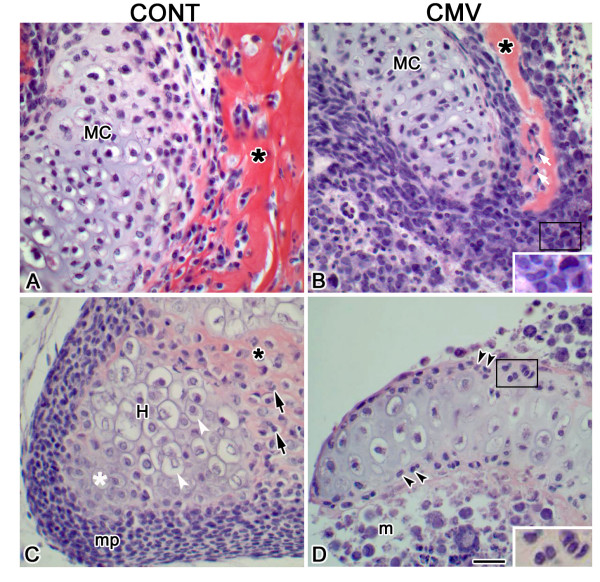Figure 3.
mCMV-induced Meckel's cartilage, mandibular bone and condylar defects in E11 + 16 MANs. A, B. Histologic analysis of Meckel's cartilage and mandibular intramembranous bone. The mCMV-infected MAN (B) is characterized by a notably smaller, dysmorphic Meckel's cartilage (MC) surrounded by infected perichondrial cells and a smaller, abnormal mandibular bone with decreased acidophilic trabecular bony matrix (*) compared to control (A). With mCMV infection, Meckel's cartilage and mandibular bone are surrounded by pleiomorphic, basophilic stromal cells. Viral inclusion bodies, found in stromal cells (B insert), osteoblasts (white arrows) and perichondrial cells, indicate infection. C, D. Histologic analysis of mandibular condyle. The control condylar cartilage (C) has formed a growth plate-like structure with characteristic zonation: a mesenchymal/progenitor cell layer (mp), a flattened chondrocyte zone (white *), a zone of hypertrophying (H) chondrocytes (white arrowhead), and an erosion zone composed of invading osteoblasts (black arrows) and deposited bony matrix (*). The mCMV-infected condyle (D) is abnormal, substantially smaller and atrophic, with a notable reduction in bony trabeculae and an increase in cartilaginous matrix being seen. The mesenchymal stroma (m) is composed of large, pleiomorphic and basophilic cells exhibiting atypical morphology and increased nuclear-to-cytoplasm ratio. The presence of viral infection in perichondrial/periostial (double arrowheads, D insert) and stromal cells is indicated by inclusion bodies. Bar, A-D: 20 μm; B, D insert: 10 μm.

